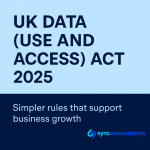
How Much Money to Start an Amazon Business in the UK? (Accountant’s Breakdown)
September 4, 2025
UK Data (Use and Access) Act 2025: new data protection regulations that make business easier for you
September 18, 2025Cash vs accrual accounting for e-commerce can sound technical, but the difference is simple: one tracks money when it moves, the other when it’s earned or owed. Here’s a clear, no-jargon guide plus a size-by-size breakdown to help you decide.
First, what do the two methods mean?
- Cash accounting: you record a sale when the cash hits your bank and an expense when you actually pay it. Easy to keep up with and great for watching cash flow.
- Accrual accounting: you record sales when you ship/fulfil (or invoice) and expenses when you’re billed, even if cash moves later. This matches revenue and costs to the right period for a truer performance picture.
Cash vs accrual accounting for e-commerce: pros & cons by business size
Solo sellers & micro stores (side-hustles, low volume)
Likely best: Cash
- Pros: Quick to maintain; easy tax estimation; mirrors bank balance; fewer adjustments.
- Cons: Can hide upcoming bills or refunds; profitability can look “lumpy” month to month.
Small but growing brands (multiple SKUs, occasional preorders/credit terms)
Likely best: Accrual (or a clear path to it)
- Pros: Cleaner margins by period; better inventory and COGS tracking; easier to compare months and plan marketing/stock.
- Cons: More bookkeeping effort; you’ll track receivables, payables and inventory properly.
Established & inventory-heavy operations (wholesale, multi-channel, 3PLs)
Best: Accrual
- Pros: Accurate gross margin; clearer unit economics; easier to raise finance and report to investors.
- Cons: Requires solid systems and month-end processes (stock counts/adjustments, cut-offs).
Quick decision helper
- If your main pain is “I just need to know cash in/cash out” → start with cash, review annually.
- If you carry stock, run promos, offer BNPL/terms, or want investor-ready numbers → go accrual.
- Planning to scale in the next 12 months? Consider moving to accrual now to avoid rework later.
Important tax notes (UK & US highlights)
In the UK, for unincorporated businesses (sole traders/partnerships), the cash basis became the default from 6 April 2024, and past turnover limits were removed. Limited companies cannot use the UK cash basis. For some businesses, traditional (accrual) accounting may still be better for accurate profit measurement and reliefs.
In the US, many small businesses can use the cash method for tax if they meet the IRS gross receipts test (inflation-adjusted; $30 million for tax years beginning in 2024). Your chosen method must be applied consistently, and changing methods may require a formal request.
Tooling tips for e-commerce bookkeeping
- Connect your sales channels (Shopify, Amazon, WooCommerce) and payment gateways to your accounting app to avoid manual entry.
- On accrual, post payouts and fees correctly, track inventory/COGS, and cut off shipments/refunds to the right month.
- On cash, still reconcile payouts, refunds, chargebacks and gift cards so cash and orders stay aligned.
Examples
Cash example: You ship an order on 30 March, but the payout lands 2 April. Cash accounting records the sale on 2 April.
Accrual example: Same order is recorded as March revenue, with March COGS for the items shipped—clearer March margin.
Need a rule of thumb?
If you’re unsure, start with cash for simplicity—but set a trigger (e.g., monthly revenue, SKU count, or inventory value) to switch to cash vs accrual accounting for e-commerce that suits your next stage. Many stores switch when inventory and marketing scale make margin tracking essential.
Disclaimer: This article is for general guidance only. Rules vary by jurisdiction and change over time. Speak to your accountant before switching methods.
